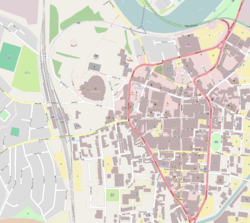Top Qs
Timeline
Chat
Perspective
Lancaster railway station
Railway station in Lancashire, England From Wikipedia, the free encyclopedia
Remove ads
Lancaster railway station (formerly Lancaster Castle railway station) is a railway station that serves the city of Lancaster, in Lancashire, England. It is one of the principal stations on the West Coast Main Line, located 20 miles 78 chains (33.76 km) north of Preston.[2]
This article needs additional citations for verification. (August 2025) |
Remove ads
History
Summarize
Perspective

Originally known as Lancaster Castle, in order to distinguish it from the Lancaster Greaves station (1840–1849), Lancaster station was officially opened on 21 September 1846. The first public service ran into the station on 17 December the same year. It was built as the southern terminus of the Lancaster and Carlisle Railway after the initial planned route for the line was changed in favour of a cheaper route west of the city; it would have followed the Lancaster Canal and crossed the River Lune from Ladies Walk to Skerton.
The station was remodelled in 1900-1906 when additional lines and platforms were added and further station buildings constructed.[3] The new buildings were styled mock-Elizabethan with the intention of mirroring the battlements of the nearby Lancaster Castle. Platforms 5 and 6 (on the east side of the station) were electrified in 1908 to serve the now-closed "Little" North Western Railway route to Morecambe and Heysham. This line closed in January 1966 and the overhead line equipment was removed.
The track layout in the station area was rationalised in 1973, when control of the signalling was transferred to the new Preston power signal box. This included the removal of the track from platform 6, although this platform had seen no regular use for some time prior to this. The West Coast Main Line through Lancaster was electrified in 1974 and regular electric passenger services commenced here on 7 May 1974.
In 2023, upgrades to the platforms canopies were announced as part of a £9.5 million investment into the station, with work continuing into 2025.[4]
Remove ads
Description
The main building, constructed in 1846 by William Tite, was situated on the west side of the line in Tudor Revival style using roughly squared sandstone rubble. This two-storey building was extended southwards in 1852 in similar style, although this section terminated in a tower of three storeys. A new entrance was constructed in 1900 on the eastern side of the line at footbridge level; this is nearer the town and houses the remaining ticket office.[3]
Facilities
The booking office is open throughout the week, closing only in the late evening; ticket machines are also available. A full range of station facilities are offered, including a newsagents, a buffet, waiting rooms and toilets, with lifts between the footbridge and platforms to enable full accessibility for disabled passengers.[5]
Remove ads
Layout
Summarize
Perspective
Platforms
Platforms 1 and 2

Platforms 1 and 2 are bay platforms which are used by terminating trains from the branch lines to Heysham Port and the Furness Line to Barrow-in-Furness, which continues to the Cumbria Coast Line to Carlisle.
Platform 3
The main entrance through the original station building opens onto platform 3, which is used mostly by northbound services on the West Coast Main Line.
Through lines
Between platforms 3 and 4, there are two through lines. They are used by non-stop passenger services and freight trains in both directions.
Platform 4

Platform 4 is an island platform with a second face, used principally for southbound trains on the West Coast Main Line.
Platform 5
Used by northbound and southbound trains and for terminating services.
Platform information
All platforms are bidirectionally signalled for arrivals and departures in either direction. Opposite platform 5 are the remains of platform 6, which has no track and has been out of use since 1973.
Services
Summarize
Perspective

Lancaster is served by three train operating companies:
- Avanti West Coast operates express trains from London Euston to Edinburgh Waverley and to Glasgow Central, using Class 390 Pendolinos. Peak services to and from London Euston terminate and start at Lancaster or Carlisle. A few services to/from Crewe also start/terminate at Lancaster.[6][7]
- TransPennine Express operates regional express services from Manchester Airport, Liverpool Lime Street and Preston to Edinburgh Waverley and Glasgow Central, via the West Coast Main Line, using Class 397 EMUs.[8]

- Northern Trains operates local and regional services along the following lines, using diesel multiple units (DMUs) of Classes 150, 153, 156, 158 and 195s:[9]
- Furness line to Barrow-in-Furness and then on to Carlisle via the Cumbrian Coast line
- Windermere branch line to Windermere, via the West Coast Main Line to Oxenholme Lake District
- Morecambe branch line to Morecambe and Heysham Port; nuclear flask trains serving Heysham power station are the other main users of this line
- Leeds–Morecambe line to Skipton and Leeds.
Morecambe, Lancaster and Heysham Port | |||||||||||||||||||||||||||||||||||||||||||||||||
|---|---|---|---|---|---|---|---|---|---|---|---|---|---|---|---|---|---|---|---|---|---|---|---|---|---|---|---|---|---|---|---|---|---|---|---|---|---|---|---|---|---|---|---|---|---|---|---|---|---|
| |||||||||||||||||||||||||||||||||||||||||||||||||
Remove ads
See also
References
External links
Wikiwand - on
Seamless Wikipedia browsing. On steroids.
Remove ads





